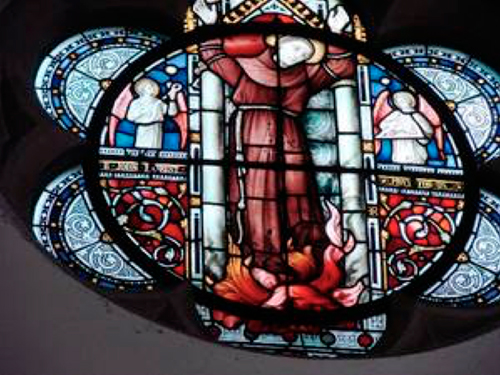A concise history of the Friars in Britain 1224
In 1224 Francis decided to send some Friars to England and appointed Agnellus of Pisa to lead a small expedition. On Tuesday, 10 September of the same year, a small boat landed near Dover and nine roughly-dressed figures disembarked, and so the Franciscan Order was implanted in England. The nine Friars were led by an Italian, Agnellus of Pisa, who had previously been Custos in Paris. It included three Englishmen who had joined the Order, probably in Paris where many Englishmen of the time went to study, five Italians and one Frenchman. Within seven weeks of arrival they had established friaries in Canterbury, London and Oxford, the ecclesiastical, political and intellectual capitals of England.
The Friars served the poor and the outcast and preached the Gospel to them. In those early days the Friars lived very poorly, receiving no money and only accepting the basic necessities of life. They ate what they begged in food, or what they were given in recompense for their work. In Canterbury, at first, they lived at the back of a schoolroom and survived by eating the leftovers from the boys' meal after the boys had finished school. But soon they were given a plot of land to build some wooden huts on for their friary. At one time in these early days one of the Friars was suffering from exposure after a journey in the snow and the only way the Friars had to warm him was to huddle up to him, because they had no way to buy firewood. Their poverty and their humble preaching gained them popularity, so the Order spread quickly, establishing houses in most major towns. We know all this because early on a Friar called Thomas of Eccleston wrote an account of the adventures of the Friars as they arrived in England.
In the years after their establishment in England they added new houses to the Province year by year: Northampton (the administrative centre of the north of England) was added in 1225; Cambridge 1226; Norwich 1226; Worcester 1227. By 1230 the Province was large enough to be divided into seven Custodies based at Oxford, Cambridge, London, York, Salisbury and Worcester. Just thirty years after arriving in England the Province consisted of 1,242 friars in 49 friaries. The Province covered Scotland and Wales as well as England and one of the first English Friars, Richard of Ingworth, was sent to establish the Order in Ireland in 1230. Agnellus of Pisa became the first Provincial Minister of the English Province and established a house of studies for the Friars in Oxford. Subsequent growth was slower as the Province settled into a more regular and less heroic life, but at the time of the Reformation in the 1530s there were approximately 1,700 Franciscans in Britain, living in 60 friaries.
Of all the activities of the Friars in England perhaps it is the Intellectual Tradition which most stands out in the Order. One German historian, Hilarion Felder, said that, apart from St. Bonaventure, all the major contributors to the Franciscan Intellectual Tradition were from the Province of England. The friary at Oxford was founded in 1224 and the friary at Cambridge in 1226. Agnellus of Pisa arranged for Robert Grosseteste (1168-1253), Bishop of Lincoln, to be the first teacher of theology to the Friars. Grosseteste was one of the leading thinkers of his day. The Franciscan involvement at Oxford would change the intellectual face of Europe. The Franciscan Oxford tradition is a impressive Who’s Who of intellectual giants, not just in the Order, but in the history of Western Thought: Adam Marsh (d. 1259); Thomas of York (d. 1260); first Franciscan lecturer at Cambridge, Richard Rufus of Cornwall, (d. c.1260-61); Roger Marston (1235-1303); William of Ware (who may have taught Duns Scotus) (f. 1270-1300); Roger Bacon (1214-1294); John Duns Scotus (1266-1308); William of Ockham (1285-1349) and John of Peckham (1240-1292), who would later become Archbishop of Canterbury and is entombed within the magnificent splendour of Canterbury Cathedral.
In 1482 the Province was reinforced by a Vice-Province of Observant Friars who lived a more rigorous poverty than was usual for the Friars of the time. This Vice-Province was favoured by Kings Henry VII and VIII and had its headquarters at the royal palace in Greenwich. By 1517 there were Observant Friars in Canterbury, Greenwich, Southampton, Richmond, Newcastle and Newark. These Observants inherited the seal and continued the Province of England in 1517, when the rest of the Friars established a separate Province of Conventual Franciscans.
The Observants were staunch defenders of Henry's marriage to Catherine and of the Supremacy of the Pope over the entire Church. One of the Friars, Elstow, even preached against Henry's divorce in the presence of the King, showing great courage and gaining a spell in prison for his pains. Consequently the Observants were the first religious to be attacked by Henry and, when they refused to be cowed, the first to be suppressed in 1534. Some were imprisoned: Bl. John Forest was martyred and many Observants went into exile to Pontoise, Paris. In 1555-1559, the friary at Greenwich was restored under Queen Mary, who remembered the Friars' loyalty to her mother, but this friary was suppressed again only four years later in 1559 by Elizabeth I. In 1559 the Observants scattered to Scotland, Pontoise and the Low Countries, although there were always those who remained in hiding in England to minister to the Catholic faithful in the years of persecution. Among those in Pontoise were: Thomas Langton, John Jones and William Stanney.
If you wish to read a fuller account of the friar martyrs among the Greenwich Observants in an article by Michael Hennessy in the Seattle Catholic of 27 July 2005, click here.

A stained glass window of the martyrdom of Blessed John Forest in the church of St Thomas of Canterbury at Woodford Green
